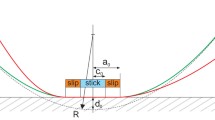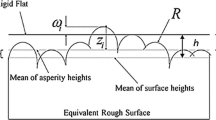Abstract
When two rough bodies slide against each other, asperities on the opposing surfaces interact with each other, defining a transient contact and heat conduction problem. We represent each body by a Greenwood and Williamson asperity model with a Gaussian height distribution of identical spherical asperities. The heat transfer during a typical asperity interaction is analyzed, and the results are combined with the height distributions to determine the mean heat flux and the mean normal contact pressure as functions of the separation between reference planes in the two surfaces. We find that the effective thermal conductance is an approximately linear function of nominal contact pressure, but it also increases with the square root of the sliding speed and decreases with the 3/4 power of the combined RMS roughness. The results can be used to define an effective thermal contact resistance and division of frictional heat in macroscale (e.g., finite element) models of engineering components, requiring as input only the measured roughness and material properties.





Similar content being viewed by others
Abbreviations
- \(a\) :
-
Contact radius
- \(a_0\) :
-
Maximum contact radius
- \(A_{{\mathrm{nom}}}\) :
-
Nominal contact area
- \(b\) :
-
Nearest approach
- \(b_0\) :
-
Maximum value of \(b\) for contact
- \(d\) :
-
Maximum interference
- \(d_0\) :
-
See Eq. (5)
- \(D\) :
-
Fractal dimension of the profile
- \(E^{{*}}\) :
-
Composite elastic modulus
- \(h_i\) :
-
Asperity height above a datum
- \(h_0\) :
-
Mean plane separation
- \(k\) :
-
Thermal diffusivity
- \(K\) :
-
Thermal conductivity
- \(m_{0,2,4}\) :
-
Moments of the power spectral density
- \(N_i\) :
-
Surface density of summits
- \(p\) :
-
Contact pressure
- \(P\) :
-
Normal contact force
- \(Pe\) :
-
Peclet number
- \(q\) :
-
Heat flux per unit area
- \(Q\) :
-
Total heat transfer
- \(R_i\) :
-
Radius of asperity summit
- \(R^{{*}}\) :
-
Composite radius
- \(S\) :
-
Sliding distance
- \(t\) :
-
Time
- \(t_0\) :
-
Half of the duration of contact
- \(T_i\) :
-
Bulk temperatures
- \(T_0\) :
-
Flash temperature
- \(\bar{T}_0\) :
-
Average flash temperature
- \(V\) :
-
Relative velocity
- \(x,y\) :
-
Cartesian coordinates
- \(\alpha\) :
-
Bandwidth parameter
- \(\theta\) :
-
Temperature difference \(T_1-T_2\)
- \(\phi _i\) :
-
Height distribution of asperities
- \(\varPhi _i\) :
-
Probability distribution for asperity interaction
- \(\mu\) :
-
Coefficient of friction
- \(\sigma _i\) :
-
Summit height standard deviation
- \(\omega _h\) :
-
Upper cut-off frequency
- \(c\) :
-
Heat flux due to temperature difference
- \(f\) :
-
Heat generated by friction
- \(i=1,2\) :
-
Bodies 1, 2
- nom:
-
Nominal contact
References
Archard, J.F.: The temperature of rubbing surfaces, Wear 2, 438–455 (1958)
Ling, F.F., Simkins, T.E.: Measurement of pointwise juncture condition of temperature at the interface of two bodies in sliding contact. ASME J. Basic Eng. 85, 481–487 (1963)
Bauzin, J.G., Laraqi, N.: Simultaneous estimation of frictional heat flux and two thermal contact parameters for sliding contacts. Numer. Heat Transf. A Appl. 45, 313–328 (2004)
Persson, B.N.J., Lorenz, B., Volokitin, A.I.: Heat transfer between elastic solids with randomly rough surfaces. Eur. Phys. J. E 31, 3–24 (2010). doi:10.1140/epje/i2010-10543-1
Bush, A.W., Gibson, R.D.: A theoretical investigation of thermal contact conductance. Appl. Energy 5, 11–22 (1979)
Sridhar, M.R., Yovanovich, M.M.: Elastoplastic contact conductance model for isotropic, conforming rough surfaces and comparison with experiments. J. Heat Transf. 118, 3–16 (1996)
Blok, H.: Theoretical study of temperature rise at surfaces of actual contact under oiliness conditions. Inst. Mech. Eng. Gen. Discuss. Lubr. 2, 222–235 (1937)
Jaeger, J.C.: Moving sources of heat and the temperature of sliding contacts. J. Proc. R. Soc. N. S. W. 76, 203–224 (1942)
Bos, J., Moes, H.: Frictional heating of tribological contacts. Trans. ASME J. Tribol. 117, 171–177 (1995)
Gecim, B., Winer, W.O.: Transient temperatures in the vicinity of an asperity contact. Trans. ASME J. Tribol. 107, 333–342 (1985)
Hou, Z.B., Komanduri, R.: General solutions for stationary/moving plane heat source problems in manufacturing and tribology. Int. J. Heat Mass Transf. 43, 1679–1698 (2000)
Smith, E.H., Arnell, R.D.: A new approach to the calculation of flash temperatures in dry, sliding contacts. Tribol. Lett. 52, 407–414 (2013)
Barber, J.R.: The distribution of heat between sliding surfaces. J. Mech. Eng. Sci. 9, 351–354 (1967)
Ling, F.F., Pu, S.: Probable interface temperatures of solids in sliding contact. Wear 7, 23–34 (1964)
Wang, S., Komvopoulos, K.: A fractal theory of the interfacial temperature distribution in the slow sliding regime: part I. Elastic contact and heat transfer analysis. J. Tribol. 116, 812–823 (1994)
Greenwood, J.A., Williamson, J.B.P.: Contact of nominally flat surfaces. Proc. R. Soc. Lond. Ser. A 295, 300–319 (1966)
Johnson, K.L.: Contact Mechanics. Cambridge University Press, Cambridge (1985)
Carslaw, H.S., Jaeger, J.C.: The Conduction of Heat in Solids, 2nd edn. Clarendon Press, Oxford (1959)
Incropera, F.P., DeWitt, D.P., Bergman, T.L., Lavine, A.S.: Fundamentals of Heat and Mass Transfer, 6th edn, pp. 283–289. Wiley, Manchester (2006)
Nayak, P.R.: Random process model of rough surfaces. ASME J. Lubr. Technol. 93, 398–407 (1971)
McCool, J.I.: Comparison of models for the contact of rough surfaces. Wear 107, 37–60 (1986)
McCool, J.I.: Relating profile instrument measurements to the functional performance of rough surfaces. Trans. ASME 109, 264–270 (1987)
Bush, A.W., Gibson, R.D., Keogh, G.P.: The limit of elastic deformation in the contact of rough surfaces. Mech. Res. Commun. 3, 169–174 (1976)
Mikic, B.B.: Thermal contact conductance: theoretical considerations. Int. J. Heat Mass Transf. 17, 205–214 (1974)
Madhusudana, C.V.: Thermal Contact Conductance, 2nd edn, p. 32. Springer, New York (1996)
Paggi, M., Barber, J.R.: Contact conductance of rough surfaces composed of modified RMD patches. Int. J. Heat Mass Transf. 54, 4664–4672 (2011)
Majumdar, A., Tien, C.L.: Fractal characterization and simulation of rough surfaces. Wear 136, 313–327 (1990)
Author information
Authors and Affiliations
Corresponding author
Appendices
Appendix 1
1.1 Effect of Relative Motion
We consider the case where \(C_2\gg C_1\), so that points on the surface of body 2 can be assumed to remain at temperature \(T_2\) throughout the contact, and for simplicity we assume that \(R_1=R_2=R\)—i.e. the asperities on the two surfaces have the same summit radius \(R\).
A representative point \((x,y)\) on the surface of body 1 will make contact as long as it remains within the appropriate contact circle in Fig. 2a—i.e. if \(\xi ^2+\eta ^2\le a(t)^2\), where \(\xi ,\eta\) and the time-varying contact radius \(a(t)\) are defined in Eqs. (2, 7) respectively. Using these relations, the inequality can be written in terms of \(x,y,t\) as
and hence
where we define dimensionless time and coordinates through
The times \(\tau _1,\tau _2\) at which contact begins and ends at a given point \((X,Y)\) are defined by taking the equality in (48), giving
It follows that the period of contact at this point is
Notice that by setting \(\Delta \tau =0\), we define the envelope of the contact regions in Fig. 2a, which is
using (49). Points outside this ellipse never experience contact. The total heat exchanged per unit area at \((X,Y)\) is given by Eq. (8) with \(C_2\rightarrow \infty\) as
and hence the total heat exchange during the interaction is
where the integration domain \(\mathcal {A}\) comprises the ellipse of Eq. (52). We obtain
which exceeds Eq. (13) [with \(R_1=R_2\)] by a factor of \(\root 4 \of {3}\approx 1.32\).
Appendix 2
1.1 Evaluation of Gaussian Integrals
Consider the integral
We define dimensionless parameters
and then perform the linear transformation
This preserves the condition
so that the Jacobean of the transformation is unity. We also have
and the domain of integration in \(J(\gamma )\) is \(\xi >\hat{h}_0\), giving
The integral with respect to \(\eta\) evaluates to \(\sqrt{\pi }\) so that finally we obtain
where
writing \(y=\xi -\hat{h}_0\). The integral \(I(\hat{h}_0,\gamma )\) can be evaluated in terms of special functions (for example using Mathematica or Maple) for integer and fractional values of \(\gamma\).
1.2 Frictional Heating
Substituting \(Q_f, \varPhi (b), \phi _1(h_1), \phi _2(h_2)\) from Eqs. (9, 22, 23) respectively into Eq. (24), we obtain
where
Evaluating the integral with respect to \(b\) and substituting for \(b_0\) from (5), we have
Substituting this result in (58) and using (56) we obtain
1.3 Heat Exchange Due to a Temperature Difference
Substituting \(Q_c, \varPhi (b), \phi _1(h_1), \phi _2(h_2)\) from Eqs. (13, 22, 23) respectively into Eq. (27), we obtain
where
after evaluating the integral with respect to \(b\). We therefore have
Rights and permissions
About this article
Cite this article
Liu, Y., Barber, J.R. Transient Heat Conduction Between Rough Sliding Surfaces. Tribol Lett 55, 23–33 (2014). https://doi.org/10.1007/s11249-014-0328-x
Received:
Accepted:
Published:
Issue Date:
DOI: https://doi.org/10.1007/s11249-014-0328-x




